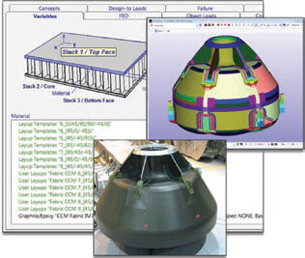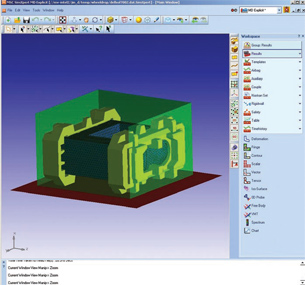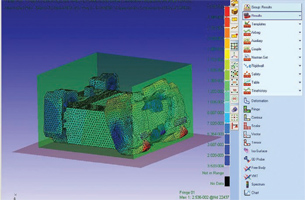Getting Specific: Exploring Niche Design Analysis Software, 2 in a Series
Part 1: Specialized packages -- computer aided engineering software designed everything from assessing composites to evaluating piping -- zero in on efficiency.
Latest News
November 1, 2008
By Pamela J. Waterman
« Page 1 | 2
 HyperSizer software offers extremely detailed structural analyses of mechanical designs, as in this NASA composite crew capsule design, when using composites of numerous types. It performs advanced statistical optimizations for combinations of loads, helping designers identify failure envelopes while designing assemblies for minimum weight. (Image courtesy of Collier Research and NASA) |
Composite Modeling
Use of composite materials, still not as well understood as traditional materials, brings both benefits and challenges to the engineering world. The properties of these customized materials can display strengths comparable to those of metals yet at a dramatically lower weight, making them increasingly attractive to engineers crafting fuel-efficient vehicles in the automotive and aerospace industries. However, understanding these materials presents complex issues as designers must predict manufacturability as well as short- and long-term behavior.
Since 1995, Collier Research has been developing NASA technology into the HyperSizer family of software targeted specifically to structural composite analysis. Material Manager helps users design laminates made with metals, foams, honeycomb cores, ply tapes, and fabrics. Users can calculate stiffness, thermal coefficients, and equivalent properties. HyperSizer Basic includes these material functions, but adds stress analysis and detailed design sizing to optimize weight while achieving structural integrity for all combinations of loads. HyperSizer Pro offers the capabilities of Basic along with coupling to third-party FEA software for advanced analysis, including updating the FEM. The software’s newest release automatically generates stress reports.
 |
MSC.Software has long been known for its family of products that handle multidisciplinary problems. One of these offerings is Dytran, an FEA solution for analyzing complex nonlinear behavior involving permanent deformation, often difficult or financially impossible to test. Translation: this software helps you simulate the behavior of small to extremely large assemblies in disastrous events, ranging from dropping a cell-phone to the impact of a ship running aground. It combines structural, material flow, and fluid-structural interaction (FSI) analysis in a single package.
The most recent release of Dytran is completely integrated into MSC.Software MD Solutions, gaining the modern GUI and pre- and postprocessing capabilities found throughout the MSC SimXpert environment. This coupling also means that users can take advantage both of Dytran’s traditionally explicit FSI solutions (for extremely transient events such as airbag inflation) and the implicit solver approach found in MD Nastran (especially useful for events such as sheet-metal forming).
 Drop test simulation of a computer using MSC.Software SimXpert Explicit. T he model is being evaluated to see how well the foam packaging around the computer absorbs the shock of the drop. (Images courtesy of MSC.Software) |
Rotorcraft Design
For engineers working on rotorcraft, gas turbines, or any systems with rotating blades, understanding the dynamic influence of resonant and forced vibrations is a critical yet potentially complex process. NISA/ROTOR is a software module from Cranes Software developed exclusively for simplifying the task of analyzing rotor bearing systems coupled to foundations, and understanding their behavior in both transient and steady-state operating conditions.
NISA/ROTOR, as part of the suite of NISA FEM products, helps engineers readily investigate the unique behavior of these rotating systems. The preprocessor lets users input bearing coefficients such as stiffness and damping, or compute the dynamic coefficients from characteristic parameters. The FE library contains the necessary elements to model a rotating shaft, disks, flywheels, bearings, foundations, and pedestals. Special solvers perform analyses in both the time and frequency domains, including those based on unsymmetrical matrices, and the postprocessor presents exact application-specific data such as critical operating speeds by way of Campbell diagrams, whirl orbits, and mode shapes showing unbalanced responses.
Piping Behavior
Another field where government regulations rule is in piping systems, whether for processing chemicals, cooling a nuclear-power plant, or pumping offshore oil. ALGOR’s PipePak package provides piping system designers with a tool for efficiently creating complete systems and performing relevant structural analyses. Typical simulations include verifying performance under thermal loads and seismic vibrations.
Weighing the Options: Broad or Niche? Specialized programs are appropriate for companies that regularly need solutions for one ongoing type of application or solutions specific to one field. Such programs allow users to easily build and solve models using the parameters and language specific to that field. The typical user might need little or no training to become and stay proficient with the software, and the packages are usually cheaper than the generalized ones. General-purpose programs solve problems from many disciplines across many industries, including the problems solved by the specialized codes. Some of these programs do so by offering plug-in, targeted modules, effectively making them specialized. A company owning generalized software has the flexibility to develop its CAE capabilities as it expands into new market areas. Some general codes even couple physical effects across multiple disciplines, greatly broadening their usage and allowing deeper understanding of the underlying physics. So, specialized programs offer lower purchase price, ease of use, and a lower cost to establish and maintain trained personnel. However, generalized programs are powerful, can solve many types of problems, and allow future expansion. If you’re not sure what path will best suit your needs, ask for advice from an analyst experienced in the codes you are considering. — Roxanne Abul-Haj, Principal Engineer, ARA Engineering |
Although such work could be done with a general FEA program, it could take hours of modeling and analysis to look at a design of just several dozen pipes. PipePak is structured to let engineers easily lay thousands of pipes point-to-point and add hundreds of fittings from a large library of standard parts. The software can import specifications from spreadsheet data and DXF files, still a common approach for this industry, or from models created in ALGOR’s FEMPRO package. It also supports industry-standard piping codes that let users evaluate proposed designs against safety code specifications.
What users consistently say about targeted software is that having menus, libraries, parameters, and input/output formats specific to their needs is an enormous time-saver. If your designs revolve around the products and services needed by a certain industry, or you always tackle a specific mechanical task, it could make real financial sense for you to check out what these niche analysis packages can offer.
More Info:
ALGOR
Pittsburgh, PA
ARA Engineering
Mesa, AZ
Collier Research
Newport News, VA
Cranes Software
Troy, MI
ESI Group North America
Bloomfield Hills, MI
MSC.Software
Santa Ana, CA
NEi Software
Westminster, CA
SIMULIA
Providence, RI
Contributing Editor Pamela J. Waterman is an electrical engineer and freelance technical writer based in Arizona. You can contact her about this article via e-mail sent to [email protected].
« Page 1 | 2
Subscribe to our FREE magazine, FREE email newsletters or both!
Latest News
About the Author
Pamela Waterman worked as Digital Engineering’s contributing editor for two decades. Contact her via .(JavaScript must be enabled to view this email address).
Follow DE





